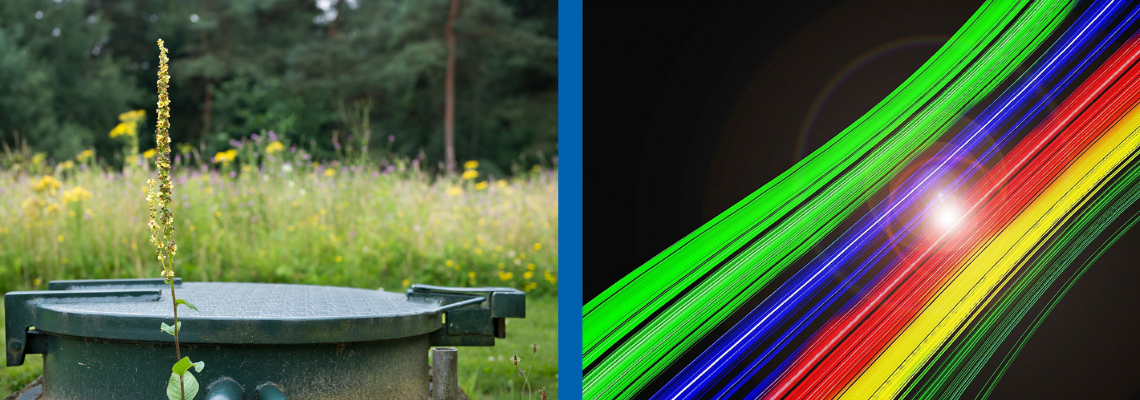Deeper underground: Vitens turns to fibre optics to measure groundwater
Superfast water data
Dutch water utility Vitens is looking at the prospect of using fibre optic cables to measure groundwater flow rates and detect blockages.
The utility is also keen to assess whether fibre optic cables can be used to optimise iron removal and the speed at which groundwater becomes contaminated by outside water flows.
The use of fibre optic cables in water networks is a fairly new idea, with UK utility Yorkshire Water piping internet cables through its network, as part of a scheme to level up the catchment area with superfast broadband.
Whereas Yorkshire Water plans to pipe the fibre optics cables through its network, Vitens is looking to use cables to provide vital data on its groundwater.
“Fiberglass cables are very suitable for measuring temperature differences along the length of the cable,” says Johannes Dunnewolt, a hydrologist at Vitens.
How does it work?
The fibre optics work by sending light waves through the cable with a laser and then measuring the reflected waves.
As the light is reflected due to imperfections in the wall of the cable, based on the intensity and wavelength of the reflected light, the temperature can be determined at different depths.
“Fiberglass cables are very suitable for measuring temperature differences along the length of the cable.”
Using this principle, Vitens is evaluating whether it can measure groundwater flows in and around water extraction wells.
"First, we set up a test set-up in a laboratory to see whether we could detect currents under ideal conditions. We have used specially prepared fibre optic cables for this,” adds Dunnewolt.
"We heat these wires to 30° Celsius and then measure with the adjacent fibre optic cables how quickly the different parts of the heating cables heat up and cool down again.”
The theory is that if the cable cools faster than the groundwater is flowing faster at this point than others - they can then translate the rate cooling into flow rate.
Three is the magic number
In 2019 Vitens installed a total of twelve fibre optic cables in and around a well of the Klooster well field.
Since then, Vitens has taken measurements generating a “significant amount of data”.
“We hope to be able to apply the measurements for three aspects,” says Dunnewolt. "The first is well blockages. If we can measure the decrease in flow velocities around and in the well with the fibre optic cables, then we can easily determine when which part of the drill wall or the filter starts to silt up."
Now that they can detect blockages Vitens can check the water level in the well.
“We hope to be able to apply the measurements for three aspects.”
"By comparing this measurement with that of the previous year, we can see whether the flow rate of the well is decreasing."
The final measurement is the flow rate, which Vitens admits requires a lot of work.
"Currently you have to remove the pump to fit the propeller into the tube. After that, the pump must be replaced again, because the measurements have to be taken during operation. And then the pump has to go out and back in again to remove the propeller," explains Dunnewolt.
"Measurements with the fibre optic cable are therefore much more attractive: they have no influence on business operations and you can do them at any time.
"The well no longer needs to be opened, which greatly reduces the risk of bacteriological contamination of the groundwater during work.”
Aspirations to unlock iron removal
Another area Vitens is hoping that fibre optic cables could revolutionise and gain a better understanding of is iron removal.
To remove iron from the groundwater, you currently need to pump underground water and regularly backwash the wells with oxygen-rich water. This can cause the iron particles around the well to oxidize and precipitate.
According to the utility, until now they did not really know how the oxygen-rich water bubble spreads in the subsoil and where the iron particles precipitate.
If we know better, we may be able to optimise this attractive method of iron removal – you prevent iron deposits in your purification installations and pipes and also have to remove less iron oxide sludge,” adds Anouk Sprong, a hydrologist at Vitens.
Related content
- 'Fibre in water'- UK utility to pipe internet cables through water network
- The Dutch demand management drive on water behaviour change
- Fatberg detecting 5G sewer 'nervous system' goed down under
Share your water technology stories with us
Do you have an innovation, research results or an other interesting topic you would like to share with the international water technology industry? The Aquatech website and social media channels are a great platform to showcase your stories!
Please contact our Sr Brand Marketing Manager Annelie Koomen.
Are you an Aquatech exhibitor?
Make sure you add your latest press releases to your Company Profile in the Exhibitor Portal for free exposure.
We promise never to send you spam and you can unsubscribe at any time!
